It’s a new Symphony of Science video from melodysheep (aka John D. Boswell). It features Neil deGrasse Tyson, Lawrence Krauss, Michio Kaku, and Morgan Freeman. It’s about black holes.
‘Nuff said. Enjoy!

Space and astronomy news
It’s a new Symphony of Science video from melodysheep (aka John D. Boswell). It features Neil deGrasse Tyson, Lawrence Krauss, Michio Kaku, and Morgan Freeman. It’s about black holes.
‘Nuff said. Enjoy!
After Iran launched a monkey in a suborbital rocket earlier this year, they are now setting their sights on sending humans to orbit, according to the Iranian news agency ISNA. The news release says researchers at the University of Haj Nasir “have designed and built a manned spacecraft,” but only images of basic designs were released.
The spacecraft appears to be a classic capsule design, and is capable of carrying “one to three people to lower orbits for several hours. This type of aircraft is made up of several modules.”
The researchers, Leila Khalajzadeh and Mehran Shams, were reported as saying in their presentation that the capsule design is the most economical type of spacecraft.
The Israeli news site Hayadan reports that Tal Inbar, head of the Space and UAV Research Center at Fisher Institute for Air and Space Strategic Studies in Israel, says that no technical data was released from Iran on the new spacecraft designs, nor have they provided information about the launch vehicle required to send the capsule to space.
According to details released earlier by the Iranian space agency, they want to launch the first sub-orbital spaceflight with an Iranian on board by 2016 at an altitude below 200 kilometers as preparation for the eventual orbital spaceflight.
Iranian participation in the future Chinese space station program has also been discussed.
Reportedly, much of Iran’s technological equipment derives from modified Chinese and North Korean technology. In 2008, Iran successfully launched a two-stage all solid-fuel sub-orbital sounding rocket called the Kavoshgar-1 (Explorer-1), for the first sub-orbital test flight from the Shahroud space launch complex. Later, in 2010-2013, at least three animal flight tests were sent on suborbital launches, some flights with outright failures, others with varying degrees of success.
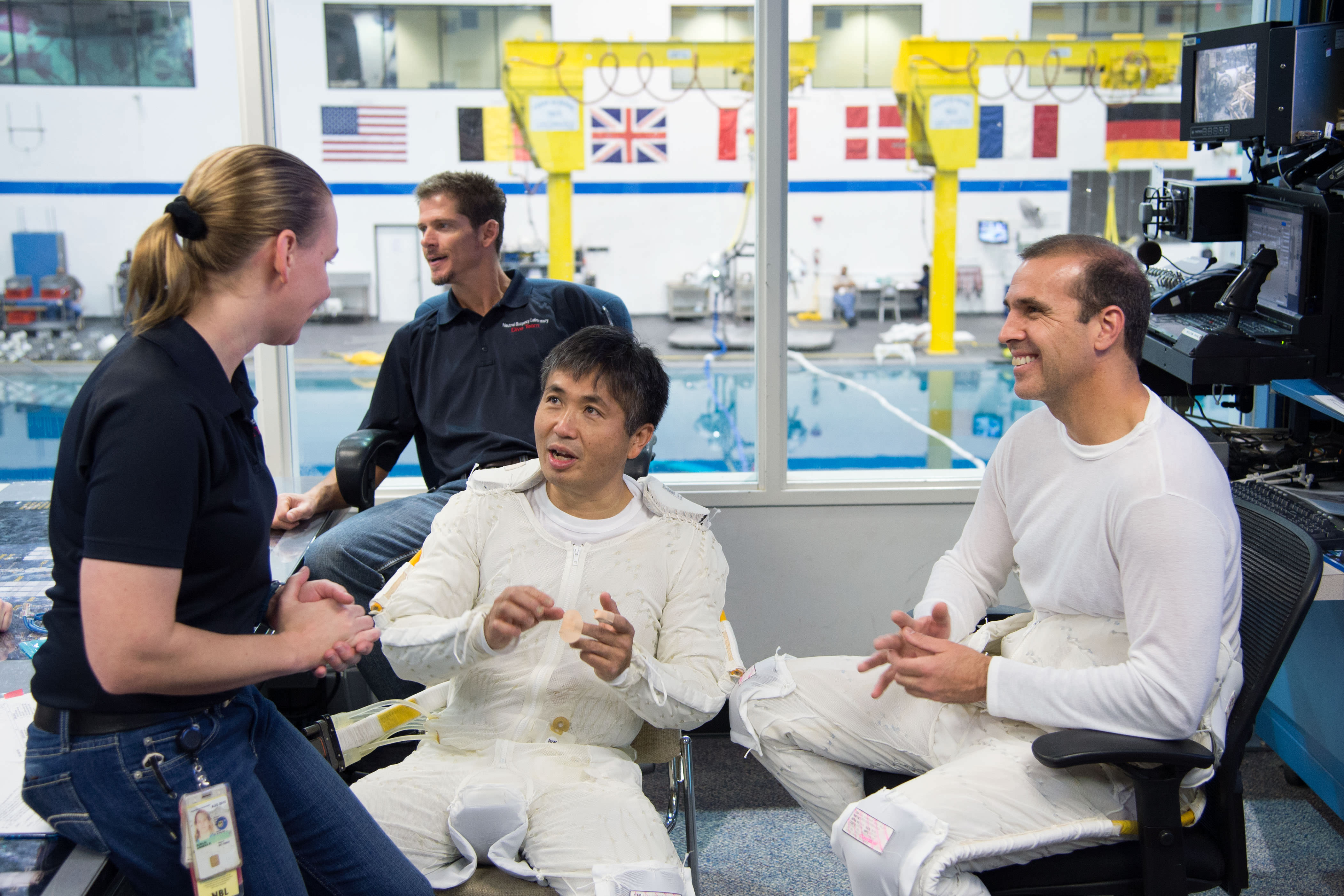
Getting into space is never a guarantee for an astronaut. Heck, getting into an astronaut program can be tough, as Koichi Wakata and Rick Mastracchio told Universe Today.
The crewmates on Expedition 38/39 are supposed to head to the International Space Station in November. But they beat incredible odds to be selected in the first place. Wakata, who is with the Japanese Aerospace Exploration Agency (JAXA), didn’t even have an astronaut program to join when he was a kid. Mastracchio (from NASA) did, but it took him nine years’ worth of applications to get in.
“When I was five years old, I saw the Apollo [11] lunar landing,” Wakata said. “This was before I was going to school, kindergarten timeframe. But there was no astronaut program in Japan, so I thought it was physically beyond my reach. It was something I longed for.”
With no Japanese astronauts to look up to, Wakata put himself in a related career: airplane engineering. Between 1989 and 1992, he worked as an aircraft structural engineer for Japan Airlines. It was while he was in this career that he saw a newspaper advertisement recruiting the first Japanese astronauts. He applied and was let in, first try.
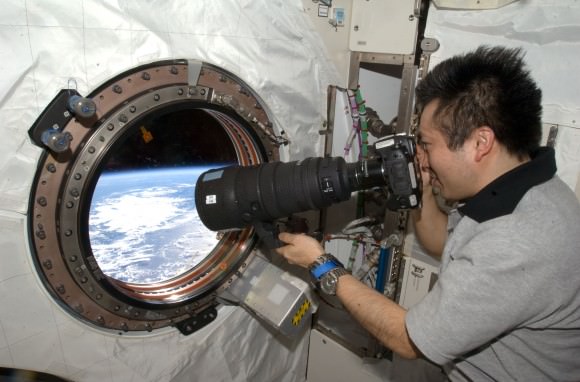
“I was lucky to get into this program,” Wakata said. And now he has a new milestone in his sights: becoming the first Japanese commander of the International Space Station during Expedition 39. Wakata’s space experience includes operating every piece of robotics hardware currently on orbit, from the Canadarm to the Japanese Kibo robotic arm.
He also has extensive leadership training behind him, which helped him prepare for command. He was in charge of an underwater lab (called NASA Extreme Environment Mission Operations, or NEEMO) in 2006. Wakata also received National Outdoor Leadership training, which puts people in wilderness situations to test their skills.
Finally, Wakata also watched closely what his own spaceflight commanders did. He is a big admirer of Brian Duffy, who flew four times in space — including two of Wakata’s missions. “I learned a lot from him and I try to imitate what he did,” Wakata said.
Unlike Wakata, his crewmate Mastracchio was born in a country with a well-established astronaut program. That also meant, however, a lot of competition. Mastracchio made applications practically every year between 1987 and 1996. Every time he was turned down, he would look for a way to make himself better for the next round.
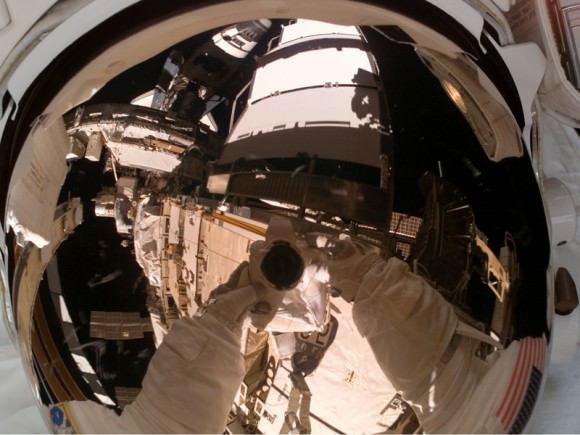
“I tried not to do things to become an astronaut. I tried to do things that I thought would be interesting,” Mastracchio said. At the same time, those interesting things happened to be items that astronauts would find useful.
Hired in 1987 for Rockwell Shuttle Operations Company in Houston, Mastracchio then moved to NASA in 1990 as an engineer in the flight crew operations directorate. He earned a masters degree in physical science at the nearby University of Houston-Clear Lake in 1991. Mastracchio also got a pilot’s license.
Around the same time of another unsuccessful selection in 1994, Mastracchio switched jobs and became a flight controller in the front room of Mission Control. It’s hard to say if that made the difference, he acknowledged, but for what it’s worth he was selected in 1996. “I just gained more experience, over time, in different jobs,” he said.
Mastracchio has since flown three times into space, performing six spacewalks in that time. There are no further “outside” activities planned for him during Expedition 38/39, but he has trained as a backup just in case.

Not only did NASA purposely crash a Marine helicopter today, but they also stuffed 15 crash test dummies inside for a group “crash” party and filmed the event from every angle imaginable. The crash test took place at the Langley Research Center in Hampton, Virginia and engineers dropped an old Marine CH-46E helicopter fuselage from a height of about 9 meters (30 feet), traveling at about 48 km/h (30 mph) to test improved seats and seatbelts and gather data on the odds of surviving a helicopter crash.
“We designed this test to simulate a severe but survivable crash under both civilian and military requirements,” said NASA lead test engineer Martin Annett. “It was amazingly complicated with all the dummies, cameras, instrumentation and the collaborators, but it went well.”
The fuselage hit hard, as evidenced by the video and images NASA has released. Thirteen instrumented crash-test dummies and two un-instrumented manikins had a rough ride, as did some of the 40 cameras mounted inside and outside the fuselage. Preliminary observations indicate good data collection, which will take months to analyze.
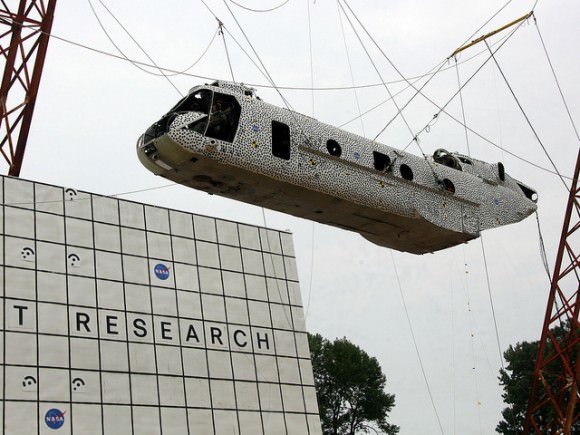
Researchers used the cameras as well as onboard computers, which data from 350 instrumentation points, to record every move of the 10,300-pound aircraft and its contents. The helicopter’s unusual black-and-white-speckled paint job — a photographic technique called full field photogrammetry — also aided in the data collection effort.
“High speed cameras filming at 500 images per second tracked each black dot, so after everything is over, we can plot exactly how the fuselage reacted structurally throughout the test,” said NASA test engineer Justin Littell.
NASA will use the results of both tests in efforts to improve helicopter performance, efficiency and safety. Researchers also want to increase industry knowledge and create more complete computer models that can be used to design better and safer helicopters.
You can see more images and video at the Langely Research Center’s Flickr page.
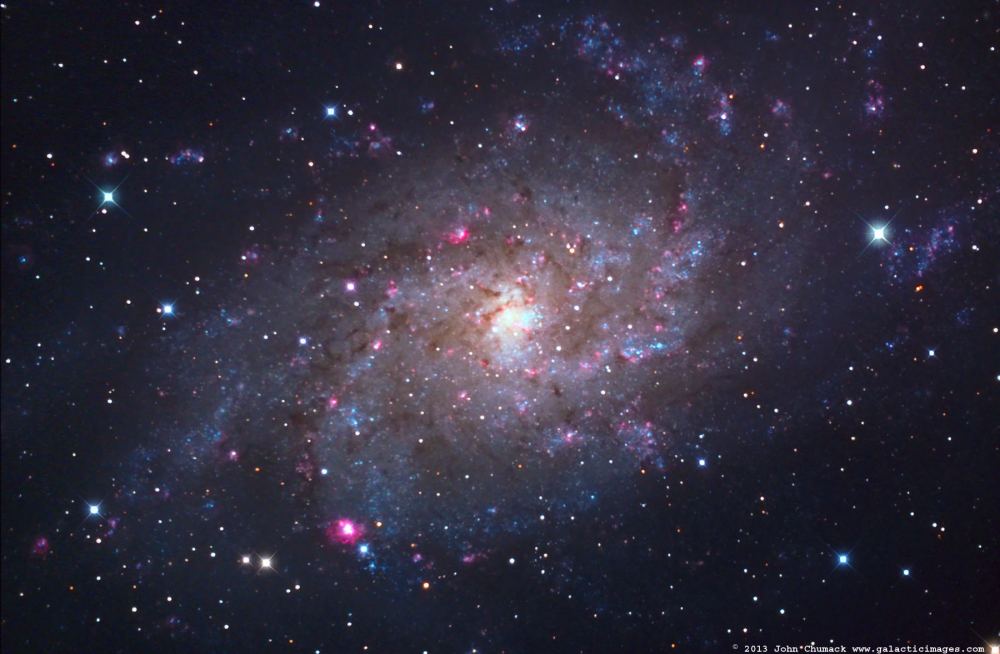
Take a look at this stunning new close-up of M33, the Triangulum Galaxy by one of our favorite astrophotographers, John Chumack. “The thing that amazes me about M33 other than it being our neighbor and a beautiful spiral galaxy, is that M33 is loaded with 292 pink nebulae (HII Star Formation Regions),” John said via email, “the largest pink nebula being NGC-604, which is actually visible in a 6″ diameter telescope…to be able to see nebula visually in other galaxies — now that is really cool!”
Your challenge for the day: how many nebulae can you count in this beautiful new image? There are also star clusters and even a few globular clusters in the image, as well.
M33 is about 2.6 million light years away and is the second closest spiral galaxy to us, next to the Andromeda galaxy. “Due to its very low surface brightness it can be a challenge to see from or nearby cities,” John explained, “but from a dark location on a perfectly clear night and assuming you have 20/20 vision, it is the furthest object the Human eye could see into deep space without optical aid.”
John used a QHY8 CCD + 16″ reflector in this 4.3 hour exposure. Pretty in pink!
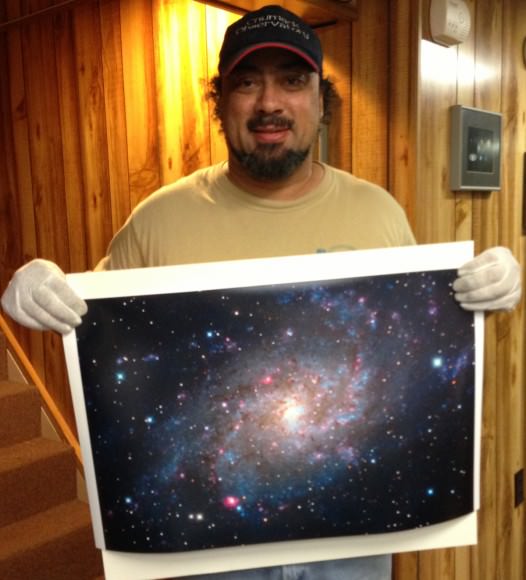
John said he always runs his images by his wife and children to get their final okay, if it looks good to them, then he knows it’s a keeper! His daughter Kayla liked this one enough to want to take a picture of her Dad holding a print of it.
See more of John’s work at his website, Galactic Images, or on his Flickr page.
Want to get your astrophoto featured on Universe Today? Join our Flickr group or send us your images by email (this means you’re giving us permission to post them). Please explain what’s in the picture, when you took it, the equipment you used, etc.
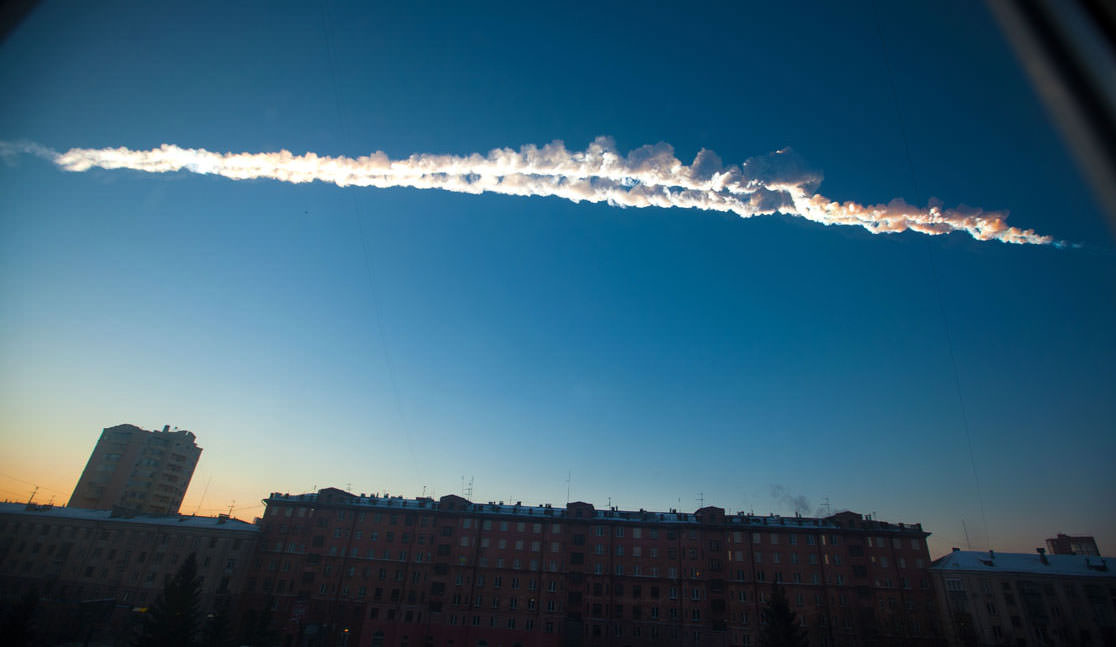
A collision or “near miss” caused melting in the Chelyabinsk meteor before it slammed into Earth’s atmosphere this February, causing damage and injuries to hundreds in the remote Russian region.
A new study, presented at the Goldschmidt Conference in Florence, Italy, says some meteorite fragments’ composition shows strong evidence of heating, which is an indication of interplanetary violence of some sort.
“The meteorite which landed near Chelyabinsk is a type known as an LL5 chondrite, and it’s fairly common for these to have undergone a melting process before they fall to Earth,” stated Victor Sharygin, a researcher from the Sobolev Institute of Geology and Mineralogy in Russia.
“This almost certainly means that there was a collision between the Chelyabinsk meteorite and another body in the solar system, or a near miss with the Sun.”
Chelyabinsk’s size of 59 feet (18 meters) was by no means a very large meteor, but it was enough to cause car alarms to go off and to shatter glass when it exploded over Russia on Feb. 15. Its arrival brought the danger of space rocks once again to public attention.
In just the few short months since its arrival, a number of research studies have begun to sketch out its origins and effects. One recent NASA study showed that the cloud of dust from the explosion spread around the northern hemisphere in days.
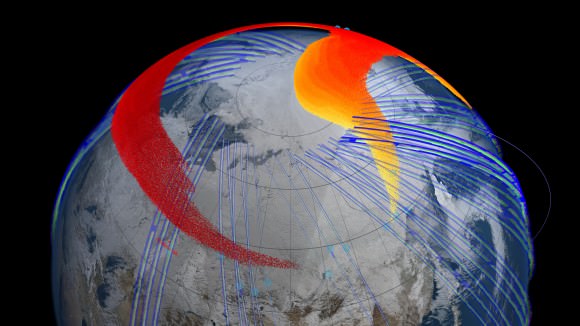
Sharygin’s team analyzed several fragments of the meteorites and put them into three groups: light, dark and intermediate. Lights ones were the most abundant. Dark fragments were most commonly found in the area where the meteorite hit the Earth.
While only three of the dark fragments show there was previous melting, the researchers say it’s quite possible that more samples might be available from the public and most notably, from the main portion that is still at the bottom of Chebarkul Lake.
“The dark fragments include a large proportion of fine-grained material, and their structure, texture and mineral composition shows they were formed by a very intensive melting process,” a press release stated.
“This material is distinct from the ‘fusion crust’ – the thin layer of material on the surface of the meteorite that melts, then solidifies, as it travels through the Earth’s atmosphere.”

Researchers also spotted “bubbles” in the dark fragments that they consider either “perfect crystals” of oxides, silicates and metal or little spots that are filled up with sulfide or metal.
They also saw platinum-type elements in the crust, which was a surprise as the time it takes for a crust to fuse is too short for platinum to form.
“We think the appearance (formation) of this platinum group mineral in the fusion crust may be linked to compositional changes in metal-sulfide liquid during remelting and oxidation processes as the meteorite came into contact with atmospheric oxygen,” Sharygin stated.
The work is ongoing, and no submission date for a study for publication was disclosed.
Source: EurekAlert!
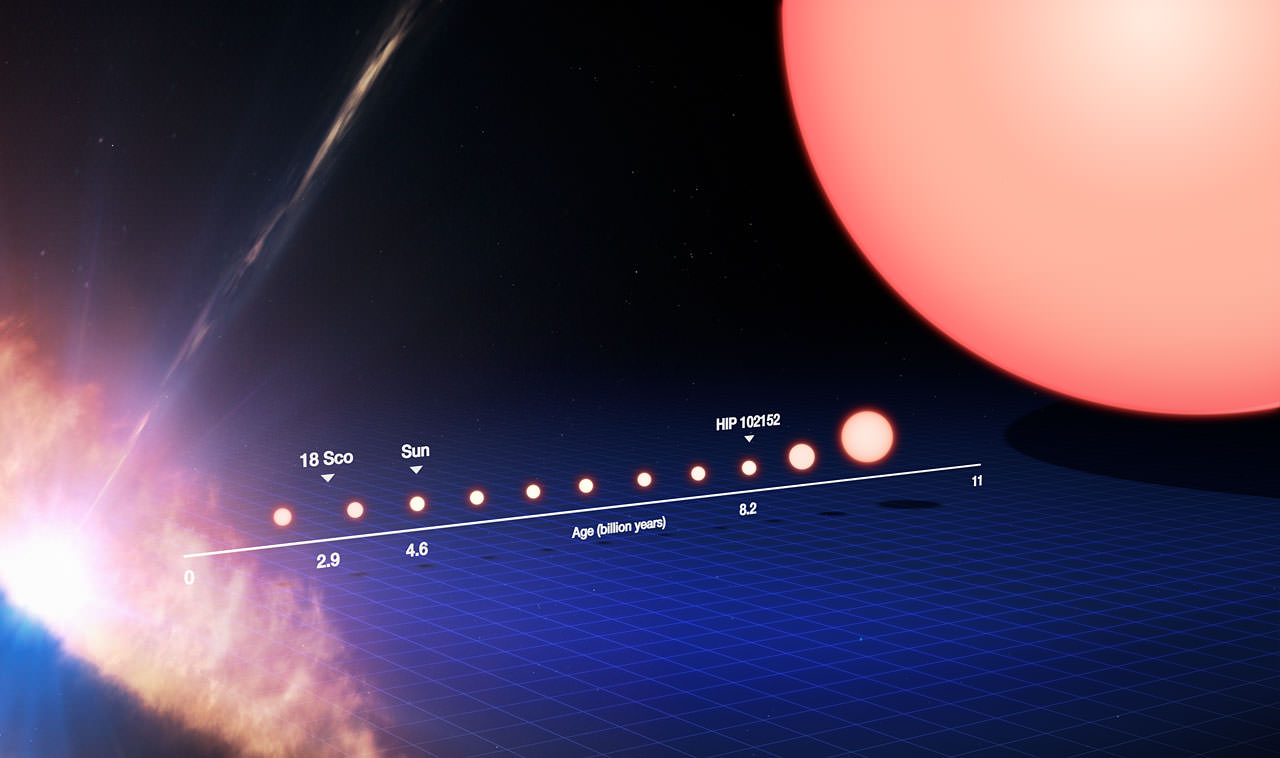
If you want a picture of how you’ll look in 30 years, youngsters are told, look at your parents. The same principle is true of astronomy, where scientists compare similar stars in different age groups to see how they progress.
We have a special interest in learning how the Sun will look in a few billion years because, you know, it’s the main source of energy and life on Earth. Newly discovered HIP 102152 could give us some clues. The star is four billion years older than the sun, but so close in composition that researchers consider it almost like a twin.
Telescopes have only been around for a few centuries, making it hard to project what happens during the billions upon billions of years for a star’s lifetime. We have about 400 years of observations on the sun, for example, which is a minute fraction of its 4.6 billion-year-old lifespan so far.
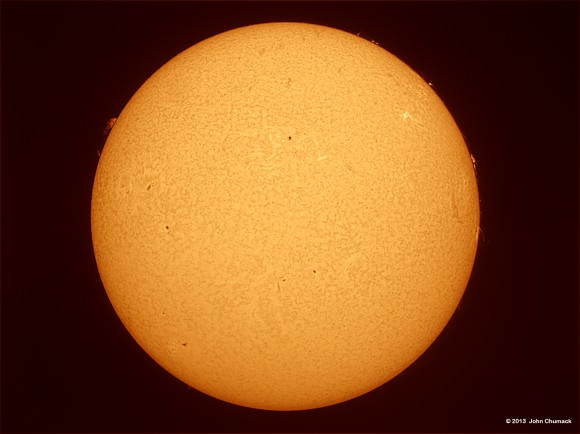
“It is very hard to study the history and future evolution of our star, but we can do this by hunting for rare stars that are almost exactly like our own, but at different stages of their lives,” stated the European Southern Observatory.
ESO’s Very Large Telescope — guided by a team led by the University of Sao Paulo’s Jorge Melendez — examined HIP 102152 with a spectrograph that broke up the light into various colors, revealing properties such as chemical composition. Around the same time, they scrutinized 18 Scorpii, also considered to be a twin but one that is younger than the sun (2.9 billion years old)
So what can we predict about the Sun’s future? One thing puzzling scientists has been the amount of lithium in our closest stellar companion. Although the Big Bang (the beginning of the universe) created hydrogen, helium and lithium, only the first two elements are abundant in the Sun.
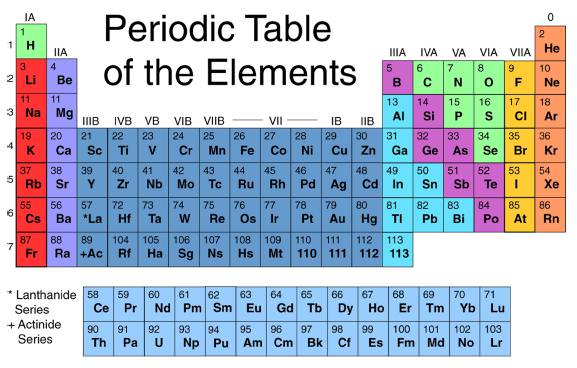
HIP 102152, it turns out, also has low levels of lithium. Why isn’t clear yet, ESO notes, although “several processes have been proposed to transport lithium from the surface of a star into its deeper layers, where it is then destroyed.” Previous observations of young Sun-like stars also show higher levels of lithium, implying something changes between youth and middle age.
The elder twin to our Sun may host another discovery: there could be Earth-sized planets circling the star. Chemical properties of HIP 102152 show that it has few elements that you see in meteorites and rocky planets, implying the elements are “locked up” in bodies close to the star. “This is a strong hint that HIP 102152 may host terrestrial rocky planets,” ESO stated.
Better yet, separate observations showed that there are no giant planets close to the star — leaving room for Earth-sized planets to flourish.
The research is available in a recent edition of Astrophysical Letters.
Source: European Southern Observatory
Determining weather patterns in exoplanet atmospheres – hundreds to thousands of light years away – is extremely difficult. However, given that it may be one of our best ways to truly characterize these alien words, it’s a challenge astronomers have accepted willingly.
Most models have a very simple foundation, necessarily eliminating the complex physics that is difficult to incorporate and analyze. Recently, a team led by Dr. Konstantin Batygin of Harvard University, added one more parameter to their models, drastically changing their results.
The punch line is this: the inclusion of magnetic fields significantly changes, and actually simplifies, the atmospheric circulation of hot Jupiters.
Hot Jupiters orbit dangerously close to their host stars, roasting in stellar radiation. But they are also tidally locked to their host stars – one hemisphere continually faces the star, while one continuously faces away – creating a permanent dayside and a permanent nightside.
One would expect the temperature gradient between the dayside and the nightside to be very high. However, various weather patterns play a role in strongly decreasing this temperature gradient. As an example, we now know that clouds may significantly decrease the temperature of the dayside.
Dr. Batygin’s team analyzed magnetic effects within atmospheric circulation. “The case of hot Jupiters is quite peculiar,” she told Universe Today. “The atmospheres of hot Jupiters have temperatures that reach up to 2000 Kelvin, which is hot enough to ionize trace Alkali metals such as potassium and sodium. So the air on hot Jupiters is actually a weakly conducting plasma.”
Once the alkali metals have been ionized – stripped of their electrons – the upper atmosphere contains all of those charged particles and becomes a plasma. It is then electrically conductive and magnetic effects must be taken into account.
While the underlying physics is pretty complex (with nearly 40 multi-lined equations in the paper alone), the introduction of magnetic effects actually simplified the model’s outcome.
In the absence of magnetic fields, the upper and lower atmospheres feature two distinct patterns of circulation. The upper atmosphere consists of winds blowing away from the dayside in all directions. And the lower atmosphere consists of zonal flows – the bands of color on Jupiter. The zonal flows move parallel to lines of latitude in an east-west fashion. Each moves in a different direction than the one above and below it.
“Upon introducing magnetic fields, fancy dayside-to-nightside flows are quenched and the entire atmosphere circulates in an exclusively east-west fashion,” explains Dr. Batygin. The upper atmosphere resembles the lower atmosphere – zonal flows dominate.
Throughout these models, Dr. Batygin et al. assumed a magnetic field aligned with the rotation axis of the planet. Future work will include a closer look at the effect of a more complicated geometry. The team also intends to extend these results to hotter atmospheres, where magnetic fields will slow the rate of these zonal flows. According to Dr. Batygin, “this has potentially observable consequences and we hope to elucidate them in the future.”
These results will be published in the astrophysical journal (preprint available here).
Scientists have detected magmatic water — water that originates from deep within the Moon’s interior — on the surface of the Moon. These findings represent the first such remote detection of this type of lunar water, and were arrived at using data from NASA’s Moon Mineralogy Mapper (M3) carried aboard India’s Chandrayaan-1 lunar orbiter.
The discovery represents an exciting contribution to the rapidly changing understanding of lunar water according to Rachel Klima, a planetary geologist at the Johns Hopkins University Applied Physics Laboratory (APL) in Laurel, Md., and lead author of the paper, “Remote detection of magmatic water in Bullialdus Crater on the Moon” published in the August 25 issue of the journal Nature Geoscience.
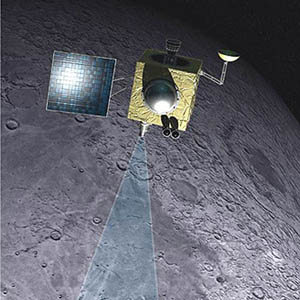
“For many years, researchers believed that the rocks from the Moon were ‘bone dry’ and that any water detected in the Apollo samples had to be contamination from Earth,” said Klima, a member of the NASA Lunar Science Institute’s (NLSI) Scientific and Exploration Potential of the Lunar Poles team. “About five years ago, new laboratory techniques used to investigate lunar samples revealed that the interior of the Moon is not as dry as we previously thought. Around the same time, data from orbital spacecraft detected water on the lunar surface, which is thought to be a thin layer formed from solar wind hitting the lunar surface.”
Read more: The Moon’s Water Comes From the Sun
“This surficial water unfortunately did not give us any information about the magmatic water that exists deeper within the lunar crust and mantle, but we were able to identify the rock types in and around Bullialdus crater,” said co-author Justin Hagerty, of the U.S. Geological Survey. “Such studies can help us understand how the surficial water originated and where it might exist in the lunar mantle.”
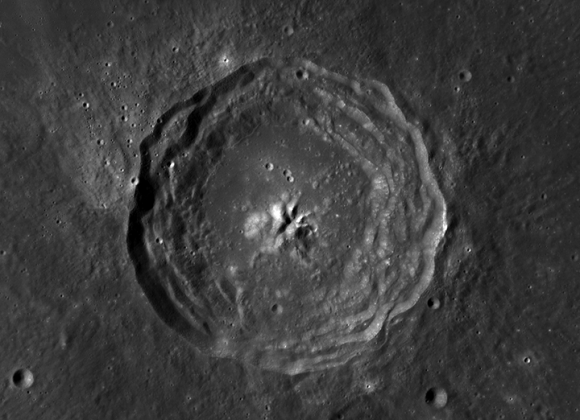
M3 (pronounced “M-cube”) fully imaged the large impact crater Bullialdus in 2009. “It’s within 25 degrees latitude of the equator and so not in a favorable location for the solar wind to produce significant surface water,” Klima explained. “The rocks in the central peak of the crater are of a type called norite that usually crystallizes when magma ascends but gets trapped underground instead of erupting at the surface as lava. Bullialdus crater is not the only location where this rock type is found, but the exposure of these rocks combined with a generally low regional water abundance enabled us to quantify the amount of internal water in these rocks.”
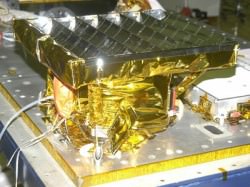
After examining the M3 data, Klima and her colleagues found that the crater has significantly more hydroxyl — a molecule consisting of one oxygen atom and one hydrogen atom — compared to its surroundings. “The hydroxyl absorption features were consistent with hydroxyl bound to magmatic minerals that were excavated from depth by the impact that formed Bullialdus crater,” Klima writes.
The internal magmatic water provides information about the Moon’s volcanic processes and internal composition, Klima said. “Understanding this internal composition helps us address questions about how the Moon formed, and how magmatic processes changed as it cooled. There have been some measurements of internal water in lunar samples, but until now this form of native lunar water has not been detected from orbit.”
“This impressive research confirms earlier lab analyses of Apollo samples, and will help broaden our understanding of how this water originated and where it might exist in the lunar mantle.”
– Yvonne Pendleton, NLSI Director
Source: JHUAPL News Release
You might be surprised to know that I have an opinion. People often ask me for it, but tend not to give it. But I was getting into a discussion with Amy Shira Teitel from Vintage Space about the priorities of humans versus robots for space explorations and offered up this opinion.
On matters of humans versus robots exploring space, this is what I think. Both, with different agendas.
Opinion: Should Robots or Humans Explore Space?
What’s the best way to explore the Solar System? Should we send humans, or robots? Robots are durable and replaceable, while humans are creative and flexible.
Space advocates line up on both sides of this discussion, and the debate can get heated.
Really heated.
Don’t be fooled. This whole conversation is a red herring.
We shouldn’t have to choose between human space exploration and robotic science, and it is absolutely ridiculous that the funding for it comes into a single agency.
The future of humanity will depend on us learning to live in space; to get off this planet and spread to the rest of the Solar System. The longer we remain trapped on this planet, the greater risk we face from a global catastrophe; whether it’s from an asteroid strike or a global plague.
We, as a species, are keeping all our eggs in one basket,
I don’t need to tell you how important science is. Our modern marvels are a direct result of the scientific method. The fact that you can even see this video (well, or read this article) should be all you need to know about the importance of science.
And we have no idea what we’ll find out there in space when we go exploring.
Were it up to me, I’d separate space exploration into two agencies, with completely different agendas and budgets.
On the science side, we need a fleet of robotic spacecraft and satellites continuously launching into space. We’d settle on a rugged, multi-purpose vehicle, which carries a variety of payloads and scientific instruments.
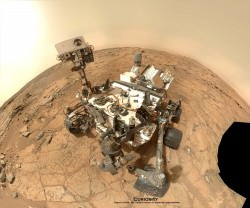
Let’s send a rover and an orbiter every two years to Mars, and similar probes to other worlds, only the scientific instruments would need change. In a few years, there would be versions of the exact same spacecraft orbiting planets, asteroids and moons.
Over time, our observation of the Solar System would extend outward like a nervous system, gathering scientific knowledge at a terrific rate.
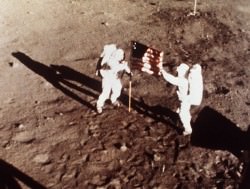
Remember the Gemini program back in the 1960s? Each mission was an incremental step more complicated than the previous one. On one mission, the goal was just to learn if humans could survive in space for 14 days. In another mission, the goal was just to learn how to dock two spacecraft together.
This gave NASA the knowledge they needed to attempt an ambitious human landing on the Moon.
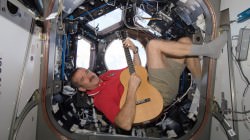
In this modern era of budget cuts, it breaks my heart that people are forced to choose between space science and human exploration.
It shouldn’t be this way. They have almost nothing in common.
Let’s do science, because science is important.
And let’s put humans in space, because humanity is important.